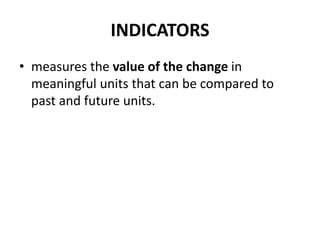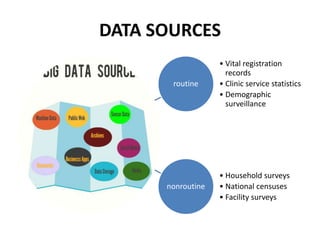monitoring and evaluation
- 1. Monitoring & Evaluation Dr. Tarek Abd-Elkader Sallam
- 2. Monitoring • Collection of routine data that measure progress toward achieving program objectives.
- 3. Monitoring • It is used to track changes in program performance over time.
- 4. Monitoring • Its purpose is to permit stakeholders to make informed decisions regarding the effectiveness of programs and the efficient use of resources.
- 5. Monitoring Examples of program elements that can be monitored: • Supply inventories • Number of vaccine doses administered monthly • Quality of service • Service coverage • Patient outcomes (changes in behavior, morbidity, etc.)
- 6. Monitoring Monitoring Counting clients Tracking IUD distributed Collecting Data on clients
- 7. Monitoring • Is an ongoing, continuous process • Requires the collection of data at multiple points throughout the program cycle, including at the beginning, to provide a baseline • Can be used to determine if activities need adjustment during the intervention to improve desired outcomes
- 8. Monitoring
- 9. Evaluation 1. Measures how well a program have met objectives. 2. The extent of changes in outcomes due to the program. 3. Measuring the “impact,” is commonly referred to as “impact evaluation.”
- 10. Evaluation
- 11. Evaluation • Data collection • at the start of a program (baseline) • at the end, • at repeated intervals during program • A control group • to measure whether the changes in outcomes can be attributed to the program • A well-planned study design
- 12. “Monitoring” or “Evaluation.” • • The National Council of Population and Development wants to know if the programs being carried out in Province A are reducing unintended pregnancy among adolescents in that province.
- 13. “Monitoring” or “Evaluation.” • USAID wants to know how many sex workers have been reached by your program this year. • A country director is interested in finding out if the post abortion care provided in public clinics meets national standards of quality.
- 14. M & E importance • • Make informed decisions regarding program operations based on objective evidence
- 15. M & E importance • • Ensure the most effective and efficient use of resources
- 16. M & E importance • Objectively assess the extent to which the program is having or has had the desired impact, in what areas it is effective, and where corrections need to be considered
- 17. M & E importance • Meet organizational reporting and other requirements, and convince donors that their investments have been worthwhile or that alternative approaches should be considered
- 18. Questions that M&E can answer 1. Was the program implemented as planned? 2. Did the target population benefit from the program, and at what cost? 3. Can improved health outcomes be attributed to program efforts? 4. Which program activities were more effective and which less effective?
- 19. WHEN SHOULD M&E TAKE PLACE?M&E continuous process that occurs throughout the program. planned at the design stage time, money, and personnel calculated and allocated Monitoring should be conducted at every stage data collected, analyzed, and used on a continuous basis Evaluations Conducted at the end of programs planned at the start baseline data 5-10% of a project budget should be allocated for M&E.
- 20. M&E PLANS M&E plan Program is modified New information is needed Revised whenever
- 21. M&E PLANS Typically, these plans include: 1. • The underlying assumptions on which the achievement of program goals depend 2. • The anticipated relationships between activities, outputs, and outcomes 3. • Well-defined conceptual measures and definitions, along with baseline values 4. • The monitoring schedule
- 22. M&E PLANS Typically, these plans include: 5. • A list of data sources to be used 6. • Cost estimates for the M&E activities 7. • A list of the partnerships and collaborations that will help achieve the desired results 8. • A plan for the dissemination and utilization of the information gained
- 23. WHY ARE M&E PLANS IMPORTANT? • State how a program will measure its achievements and therefore provide accountability • Document consensus and provide transparency • Guide the implementation of M&E activities in a standardized and coordinated way • Preserve institutional memory
- 24. M&E PLAN COMPONENTS 1. • The introduction 2. • The program description and framework 3. • A detailed description of the plan indicators 4. • The data collection plan 5. • A plan for monitoring 6. • A plan for evaluation 7. • A plan for the utilization of the information gained 8. • A mechanism for updating the plan
- 25. M&E PLAN COMPONENTS INTRODUCTION • The introduction to the M&E plan should include: • The purpose of the program, the specific M&E activities that are needed, and their importance • • A development history that provides information about the motivations of the internal and external stakeholders
- 26. M&E PLAN COMPONENTS: DESCRIPTION AND FRAMEWORKS 1- A problem statement situation that needs changing The affected Causes magnitude, Impact on society
- 27. M&E PLAN COMPONENTS: DESCRIPTION AND FRAMEWORKS • The program goal and objectives: The goal is a broad statement about a desired long-term outcome Objectives are statements of desired specific and measurable program results
- 28. M&E PLAN COMPONENTS: DESCRIPTION AND FRAMEWORKS Descriptions of the specific interventions duration, geographic scope target population
- 29. M&E PLAN COMPONENTS: DESCRIPTION AND FRAMEWORKS The list of resources needed financial, human, Infrastructure (office space, equipment, and supplies)
- 30. M&E PLAN COMPONENTS: DESCRIPTION AND FRAMEWORKS The conceptual framework which is a graphic depiction of the factors thought to influence the problem of interest and how these factors relate to one another
- 31. M&E PLAN COMPONENTS: DESCRIPTION AND FRAMEWORKS The logical framework or results framework that links the goal and objectives to the interventions
- 32. M&E PLAN COMPONENTS: DESCRIPTION AND FRAMEWORKS SMART” objectives Specific: Measurable: Appropriate: related to the goal Realistic: Timely:
- 33. M&E PLAN COMPONENTS: DESCRIPTION AND FRAMEWORKS • Here is a sample objective. Do you think it is SMART? Increase contraceptive prevalence by 15% in women 30-49 years
- 34. M&E PLAN COMPONENTS: DESCRIPTION AND FRAMEWORKS Increase contraceptive prevalence by 15% in women 30-49 years 1. Specific: Yes, the intended outcome of the program is specified 2. Measurable: Yes, contraceptive prevalence is measurable. 3. Appropriate: Unknown, because no program’s goal 4. Realistic: Unknown, because no resources 5. Timely: No
- 35. M&E PLAN COMPONENTS: INDICATORS Indicators are clues, signs, or markers that measure one aspect of a program and show how close a program is to its desired path and outcomes. The M&E plan should include descriptions of the indicators.
- 36. M&E PLAN COMPONENTS: INDICATORS Examples of indicators: • Number of health workers trained in IUD insertion in the past 12 months • Percentage of women of reproductive age who are using a contraceptive method at a particularpoint in time • The number of maternal deaths per 100,000 live births in a specific period
- 37. M&E PLAN COMPONENTS: DATA SOURCE AND DATA COLLECTION • Data sources • The data collection plan
- 38. M&E PLAN COMPONENTS: DATA SOURCE AND DATA COLLECTION • Examples of data sources are: 1. • Birth registers 2. • Sentinel/demographic 3. • Surveillance 4. • Censuses 5. • Focus groups 6. • Household surveys
- 39. M&E PLAN COMPONENTS: MONITORING PLAN • The monitoring plan describes: 1. Components that will be monitored 2. How this monitoring will be conducted 3. The indicators that will be used to measure results
- 40. M&E PLAN COMPONENTS: EVALUATION PLAN The evaluation plan research design identify whether changes in outcomes can be attributed to the program
- 41. M&E PLAN COMPONENTS: INFORMATION DISSEMINATION and USE Help ensure that findings from M&E efforts are not wasted because they are not shared. The various users of this information should be clearly defined. Dissemination channels can include written reports, press releases and stories in mass media, and speaking events.
- 42. FRAMEWORKS • A conceptual framework useful for identifying and illustrating the factors and relationships that influence the outcome of a program or intervention.
- 43. FRAMEWORKS Results frameworks diagram the direct causal relationships between the progressive results of the key activities all the way up to the overall objective and goal of the intervention. This clarifies the points in an intervention at which results can be monitored and evaluated.
- 44. FRAMEWORKS
- 45. FRAMEWORKS • LOGIC MODELS • Provides a streamlined, linear interpretation of a project’s planned use of resources and its desired ends.
- 49. INDICATORS • Is a variable whose value changes from the baseline level at the time the program began to a new value after the program and its activities have made their impact felt. At that point, it, is calculated again.
- 50. INDICATORS • measures the value of the change in meaningful units that can be compared to past and future units.
- 51. INDICATORS • focuses on a single aspect of a program or project. • This aspect may be an input, an output, or an overarching objective, but it should be narrowly defined in a way that captures this one aspect as precisely as possible.
- 52. Types of INDICATORS • measure the specific resources • amount of funds allocated to the health sector annuallyinputs • measure the immediate results • Ex. number of staff trained outputs • measure whether the outcome changed in the desired direction • example, contraceptive prevalence rateoutcomes
- 53. CHARACTERISTICS OF INDICATORS • Produce the same results when used repeatedly to measure the same condition or event • Measure only the condition or event it is intended to measure • Reflect changes in the state or condition over time • Represent reasonable measurement costs • Be defined in clear and unmistakable terms
- 56. LINKING INDICATORS TO FRAMEWORKS A. Provision of support and supplies to community-based distributors B. Expanding family planning services to additional clinics C. Clinical training for providers D. The development of a checklist to monitor the quality of care E. Management training for supervisors
- 59. GUIDELINES FOR SELECTING INDICATORS • Select indicators requiring data that realistically can be collected with the resources available. • Select at least one or two indicators (ideally, from different data sources) per key activity or result. • Select at least one indicator for each core activity (e.g., training event, social marketing message, etc.). • Select no more than 10–15 indicators per area of significant program focus. • Use a mix of data collection sources whenever possible.
- 60. DATA SOURCES routine • Vital registration records • Clinic service statistics • Demographic surveillance nonroutine • Household surveys • National censuses • Facility surveys
- 61. DATA COLLECTION • The plan should include information for each data source such as: 1. • The timing and frequency of collection 2. • The person/agency responsible for the collection 3. • The information needed for the indicators 4. • Any additional information that will be obtained from the source
- 62. DATA COLLECTION • Some types of errors or biases common in data collection are: 1. • Sampling bias: Occurs when the sample is not representative 2. • Nonsampling error: All other kinds of mismeasurement, such as courtesy bias, incomplete records, incorrect questionnaires, interviewer errors, or nonresponse rates 3. • Subjective measurement: Occurs when the data are influenced by the measurer
- 63. DATA COLLECTION data quality issues to consider: Coverage: Completeness: Accuracy: Frequency: schedule: Accessibility: Power:
































































